Hello and welcome!
Of course, this week we are all looking forward to the canonization of Mother Teresa in Rome on Sunday.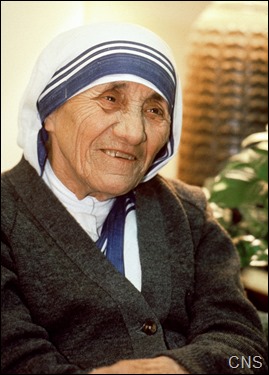
Probably after Pope John Paul II, she is the person most seen and known by Catholics in the world today because of her extensive travel, presence and missionary experience. Her canonization, coming as part of the Jubilee Year of Mercy, is a wonderful tribute to her vocation and the work of the Missionaries of Charity.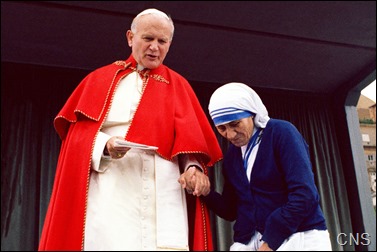
I first met Mother Teresa as a young friar when I was teaching at Catholic University of America, even before my ordination. We were informed that the university was going to honor a missionary nun, and that there would be some sort of a convocation at Caldwell Hall, which is a medium-sized auditorium.
To be honest, at first, I just kind of ignored it. But then later I thought, “Well, not many people are going to go to this, and I’m a religious and this poor missionary is here, so I should at least show up.”
So, I went to Caldwell Hall and, sure enough, there were only about 20 or 30 people in the whole auditorium. However, to my surprise, the Cardinal Archbishop of Washington was there on stage and with him was a laywoman and a small Indian woman, who I thought they must have brought along.
The laywoman got up — her name was Eileen Egan and she was the head of Catholic Relief Services — and she introduced Mother Teresa. Eileen spoke about how, one day in the slums of Calcutta, she saw a wheelbarrow coming towards her, and in it was a dying man all covered with maggots. She said it looked as if the wheelbarrow was traveling under its own power until she saw the short nun on the other side pushing it. Of course, that nun was Mother Teresa.
Eileen Egan with Mother Teresa
Eileen asked Mother Teresa, “Where are you taking this man?” And she answered that she was taking him to an abandoned Hindu temple where the sisters took dying people from the streets so they could die, as Mother Teresa always said, surrounded by love. And Eileen went on describing the work of Mother Teresa. Then Mother Teresa got up and spoke, and everyone was weeping, it was just so powerful.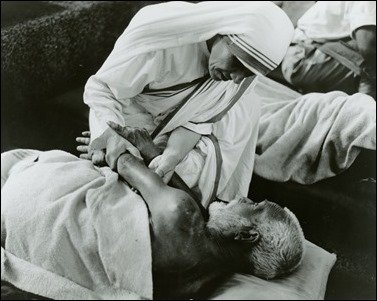
Afterwards, I got up my courage to approach the Archbishop (who was a wonderful man, but sort of a curmudgeon) and I said, “Your Eminence, this is the biggest blunder I’ve seen at the Catholic University.” He said, “What do you mean brother?” And I answered, “This should have been in the National Shrine, and you should have made all the students and faculty come and see this woman!” And he agreed.
As I said, at this point, none of us had heard of Mother Teresa before. It was only afterwards that Malcolm Muggeridge of the BBC decided to make a television program about her called “Something Beautiful for God.” The title came from the time he asked her, “Mother what are you doing?” and she answered, “Well, I’m trying to do something beautiful for God.”
In fact, it made such an impact on him that he became a Catholic.
Of course, after that, Mother Teresa became internationally known, she won the Nobel Prize and her community, which was once basically just a small group of her students from when she was a Loreto Sister, expanded incredibly. I think now the Missionaries of Charity have about 3,000 sisters working with the poorest of the poor in hundreds of places throughout the world.
When I was in the West Indies, I asked her to send me sisters, and she did shortly before I left for Fall River. Then, when I came to Fall River, it was just after the terrible scandal in the diocese, and I told her that the sisters would be a healing presence in the diocese. Immediately, she sent me another community for New Bedford.
She later visited her sisters in New Bedford. They had a house in St. Lawrence Parish, and so they had a huge Mass there with Mother. I celebrated the Mass, which was in Portuguese, Spanish and English, and afterwards Mother Teresa addressed the people. It was sort of a rainy day and St. Lawrence is a very large church, but when you looked out – we had loudspeakers outside – it was just a sea of umbrellas as far as the eye could see in every direction.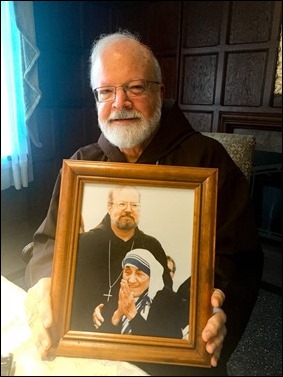
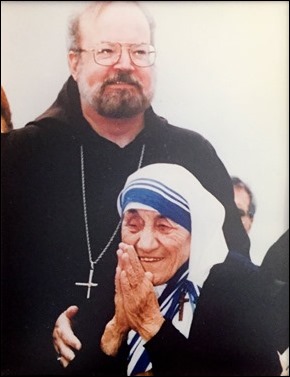
By the time Mass was over, it had stopped raining and Mother went out. The people lined up by the hundreds to meet her. I could see that she was giving out these little cards, as well as miraculous medals, which she always did. This card intrigued me, so I got in line to get one, too.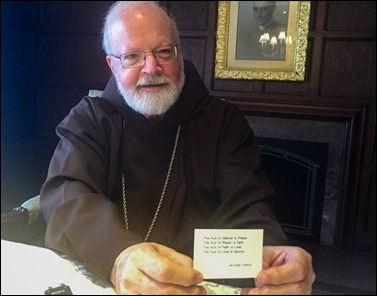
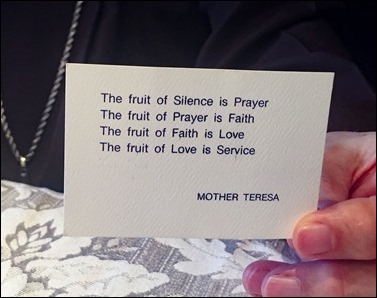
It was my privilege to be with Mother Teresa on many occasions, in many different parts of the world — in Cuba, Nicaragua, Rome, New York and Washington. It is kind of unbelievable that someone that I saw so often is now becoming a saint. Sometimes, when I’m celebrating Masses for her, I will ask the people, “How many of you met Mother Teresa in person?” and all the hands go up.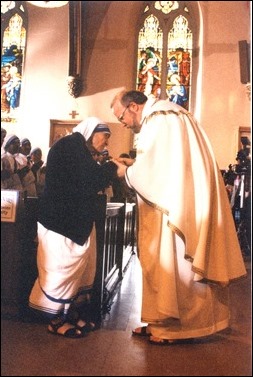
She really had a connection with so many people, and so her canonization is a time of such joy. I know that the crowds in Rome are going to be just overwhelming. I had been planning to attend since the announcement of the canonization was made, but with the recent death of one of my aunts, I need to be with my family, and that would not allow me to make it to Rome on time. However, it will allow me to celebrate a Mass at Mother Teresa Parish in Dorchester with our local sisters. So, on the morning of the canonization, we will have our own “little canonization” here in the archdiocese.
– – –
This week, I celebrated the Mass of the Holy Spirit to open the academic year at our three seminaries in the archdiocese.
On Wednesday, I celebrated Mass at St. John’s seminary in Brighton. 
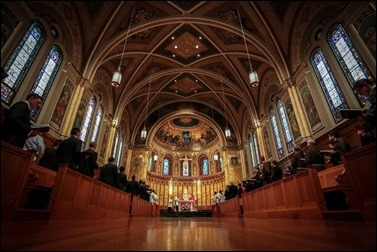
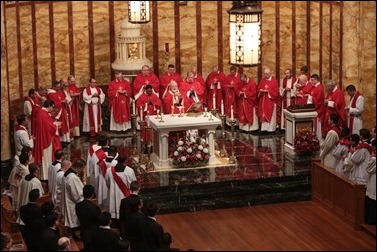
Thursday, I visited Redemptoris Mater Seminary in Brookline.

And, earlier today, I went to Pope St. John XXIII National Seminary in Weston. 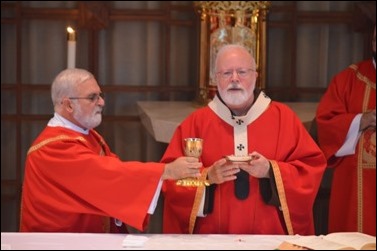
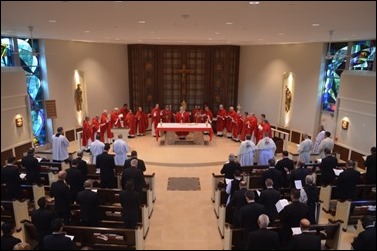
We are very blessed to have about 200 men studying in these three seminaries.
Preparing men for ministry in the Church is a very important part of our mission, and we are very grateful that God has sent us so many vocations that our seminaries are filled. We are also grateful for the work of our formators, our benefactors, and all those who pray for vocations and work to support our Vocations Office.
At the celebration at Pope John Seminary we also had the joy of installing the new rector, Father Brian Kiely who is a priest of the Archdiocese of Boston with extensive parish experience.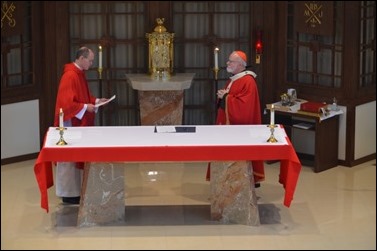
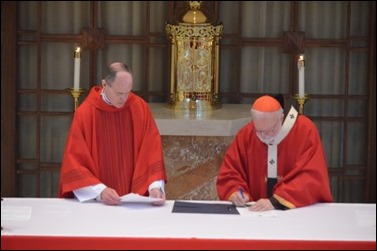
This is a seminary mainly to prepare men to be parish priests and Father Kiely has been a very successful and creative pastor in many different settings — from suburban, to inner city, to mission parishes. So, I feel very confident that his experience and priestly zeal are going to be a great asset in his direction of the seminary that services, not just Boston, but dioceses throughout the country and the world.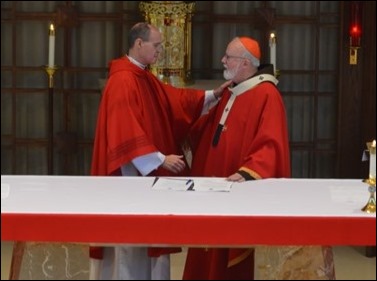
Pope St. John’s seminary was instituted by Cardinal Richard Cushing for “second career vocations” for older men. Some of them are widowers and the majority of them had previous professions and careers. It was Pope John who said once that a vocation can come at any time in your life. That inspired Cardinal Cushing to found this seminary to provide a place for men who are beyond the traditional age to have a place where they could receive the specialized training and formation they would need for parish ministry.
I’d like to share with you the homily I delivered at the seminaries this week:
Being a Catholic priest can bring us a certain amount of goodwill, privilege and perks. I remember once leaving College in a hurry to get to St. Matthew’s Cathedral for a funeral and was stopped at a speed trap on Michigan Avenue by a big Irish cop. It was only after the policeman stopped me that I realized that there were a line of cars that had been pulled over. When the policeman saw the habit, he stuck his head in the window and whispered: “Father, for your penance say three Our Fathers and three Hail Marys, and now drive away…Slowly.” It’s nice to be having dinner in Victoria’s diner and learn from the waitress that some anonymous patron has picked up the tab, but this is not what the priesthood is about. It has little to do with our identity.
Earlier this month, I went to visit Auschwitz once the World Youth Day was over. Our Friars arranged to have someone take me to the very spot where Maximilian Kolbe offered to take the place of a young man who was to be executed in retaliation for an escaped prisoner. The young man was overwhelmed at the thought of leaving behind his wife and children and he cried out in grief. Father Maximilian stepped forward and said: “Let me go in his place.” The Nazi officer shouted: Who are you?” To which Maximilian Kolbe said: “I am a Catholic priest.” I often commented on the fact that Graham Greene does not give us the name of the priest in his book, The Power and the Glory, nor does he name his replacement who shows up immediately after the priest is shot by the firing squad.
To be a priest does mean dying to self, giving up something of our own identity to become an icon of the Good Shepherd. “I am a Catholic priest.” It says it all, his nationality, his name, his passport, his age, his looks, did not matter; the only thing that mattered was at that moment, he was a Catholic priest, ready to lay down his life for his flock who in this case consisted of a stranger. But for a Catholic priest, no one is just a stranger. Christ said: “I was a stranger and you welcomed me.” For a Catholic priest, even a stranger is part of his flock, part of his responsibility.
When Maximilian Kolbe says: “I am a Catholic priest, he is telling the world that, like Jesus, he is both priest and victim, and sees his identity in terms of self-giving. This heroic act of Maximilian Kolbe was the culmination of a life of sacrifice and service. He was 47 years old. He had not yet celebrated his silver jubilee of ordination, but he could truly say: “I am a Catholic priest.” His life of prayer, fidelity, sense of mission, filial devotion to Mary Immaculate, all helped shape that priestly identity.
To be messengers of Christ’s love and mercy, we need to be men who are transformed by the gospel. The call to priesthood is always a call to ongoing conversion.
Last week we bishops of the region gathered for retreats at Kennebunkport. During the retreat I read The Rule and Testament of St. Francis and our Capuchin Constitutions as part of my spiritual reading. For us Capuchins, The Testament of St. Francis is the official commentary on the Rule.
Francis wrote his last Testament shortly before he died. This precious document begins: “This is how God inspired me, Brother Francis, to embark upon a life of penance. When I was in sin, the sight of lepers nauseated me beyond measure; but then God himself led me into their company, and I had pity on them. When I had once become acquainted with them, what had previously nauseated me, became a source of spiritual consolation for me. After that, I did not wait long before leaving the world behind.”
Francis’ vocation and life of conversion began at the same time. I believe a call to a vocation is always a call to conversion. Francis says that when he was in sin he couldn’t stand to see lepers. They disgusted him. He would run away. But then the Lord led Francis among the lepers, and instead of running from the lepers, he gave them his money, his clothes and he kissed them. That was the beginning of his metanoia, when he practiced signs of mercy. The Italian translation is: “usai Misericordia”, in Latin, feci Misericordiam. Francis says: “I used mercy, I made mercy.” And in using mercy, Francis is healed. His heart is changed, what was bitterness now becomes sweetness. The leper has cured Francis. And now the leper is a neighbor, is a brother, is Christ.
We open the seminary this year during the Jubilee of Mercy. I urge all of you, my seminarians, to “use mercy”, to make mercy, and in doing that your own conversion will be deepened and your priestly vocation will be strengthened.
The account Francis gives us of his vocation is beautiful. He is aware of his own sinfulness and how God invites him and transforms him by placing him with the leper. Once Francis practices mercy, his own spiritual maladies are cured. Francis says he immediately began to love churches, to love priests, to love the Eucharist, and it all began with an act of mercy.
So many of the vocation stories in the Gospel are about Jesus calling people to conversion, to discipleship, and to ministry. The Gospels describe the dramatic conversion of Levi who is exploiting the poor and betraying his own people when Jesus draws near and invites him: “Follow me.” The Acts of the Apostles documents the stunning conversion of Saul, the fanatic enemy of the church, who is transformed into the apostle Paul.
As seminarians, you are here to discern a vocation to the priesthood. Responding to a vocation, to discipleship and conversion must be the first step. This all begins with an awareness that Christ has cast his loving gaze on us and is calling us to conversion, to discipleship, to friendship.
The context for our response to the call, to conversion, and to ministry is the mercy of God that we celebrate in this Jubilee. Sister Faustina defined the Divine Mercy devotion in three aspects; to ask for and obtain the mercy of God, to trust in Christ abundant mercy, and finally to show mercy to others and act as a conduit for God’s mercy toward them. What a beautiful program for the Year of Mercy.
The Divine Mercy image of Christ’s heart is always accompanied with the words, “Jesus I trust in thee.” We must learn to trust in Jesus’ love which surpasses all imagination.
In the beautiful gospel today, Jesus is urging us not to worry about our clothes, our food, our money, our health, our life. He tells us: “Do not be afraid. Your Father is pleased to give you the kingdom. Sell your belongings, give to the poor, have the freedom to follow me. Where your treasure is, there also your heart will be.”
Our treasure is Jesus Christ. He is that hidden treasure that once found, is worth renouncing everything to acquire. Behold the lilies of the field, they toil not nor do they spin, but I tell you not even Solomon in all his splendor was arrayed as one of these.”
Jesus wants us to trust in his love. That is the beginning of our conversion and the beginning of our vocation.
During this Year of Mercy, let us respond to the Holy Father’s challenge to trust in God’s mercy, to seek God’s mercy, and to practice mercy. When we take God’s healing to others, we are healing our own heart and preparing ourselves for the day when before the world we will be able to say: “I am a Catholic priest” the way that Maxmilian Kolbe did.
The seminary is here to help prepare you for that day when you too can say: “I am a Catholic priest.” In the past, I believe that the academic formation often eclipsed other aspects of priestly formation, in part because it’s easily measured. The Church is now acutely aware of the importance of the human, spiritual, and pastoral formation which must also be part of the seminary experience.
Here you must learn to be men of prayer, and learn to be brothers. At the first ordination, Jesus prays for unity among us and tells us to love each other. Do not let yourselves become cynical or promoters of division and polarization. Look to be fraternal, humble and genuinely concerned about each other’s welfare. That is when the Catholic priesthood is at its strongest. Prayer and fraternity will put you in good stead to face the challenges and temptations that can destroy your ministry.
Recently, our provincial, who has been pastor of the Chinese parish for many years, shared with us the story of one of his parishioners. Back in China, this man used to offer his house for clandestine Masses. One day there was a police raid and the priest and worshipers fled. The man was arrested and tortured because he would not reveal the whereabouts of the priest. He said that his people had gone for years without the sacrifice of the Mass and he did not want to jeopardize the possibility of the Eucharist. The man was eventually released and left China and came to Philadelphia where he was a very active parishioner in the Chinese parish. He soon opened a little restaurant that served Chinese food until the wee hours of the morning. It was very successful and eventually, he opened more and more restaurants and became more involved in his business to such an extent that he stopped coming to Sunday Mass and only showed up at Christmas and Easter. It is ironic that although torture and threats could not undermine his devotion to the Mass, materialism and the extreme individualism of our secular culture separated him from the worshiping community.
It is very unlikely that any of us will be dragged into prison and tortured by a totalitarian government like St. Maximilian Kolbe was. But the toxic influence of a culture of unbelief, addicted to entertainment and creature comforts can be more effective at separating us from our vocation than the cattle prod, waterboarding or the other methods of torture applied to prisoners of conscience. Pope Francis warns us about the materialism, vanity, careerism and pleasure seeking culture that he refers to as worldliness. This worldliness can rob us of our ardor and zeal. Hence the seminary is so crucial. I hope that you will learn to care about each other and take care of each other. Build a strong priestly fraternity, an intentional presbyterate beginning right now with strong fraternal relationships based on your desire to live a life of faithful discipleship together.
Cultivate a deep trust in God’s loving Providence for you. See your connectedness to Christ and your brothers as the source of your strength to advance your personal conversion and to embrace your vocation joyfully and generously.
Time is precious. Use the time of being in the seminary well. Embrace the discipline a priest needs to be faithful to his calling. Punch and Judy have been the Scylla and Charybdis that have shipwrecked many a vocation. Have a rule of life you develop in consultation with your spiritual director. I always encourage our priests to participate in support groups, and it is our hope that pastoral planning will allow all of our priests to live in community, even when we have enough priests to be pastors in individual parishes, hopefully in the near future.
Fall in love with Christ, with his bride, the Church, and with your vocation. Often times we hear about people’s emotional fragility today and a lack of toughness. David Brooks has a fascinating article this week in the New York Times in which he writes: People are much stronger than they think they are when in pursuit of their telos, their purpose for living. As Nietzsche put it: “He who has a why to live for, can bear almost any how.” We are all fragile when we don’t know what our purpose is, when we haven’t thrown ourselves with abandon into a social role, when we haven’t committed ourselves to certain people, when we feel like a swimmer in an ocean with no edge. As Brooks says: “the antidote is to be idealistic, committed to a worldview that puts temporary pain in the context of a larger hope.” Well, Christ is that hope. Our lives are based on our trust in his love. He is the buried treasure that once discovered, leads us to sacrifice all for its attainment. And when our hearts are where our treasure is, where Christ is, then our lives make sense and our vocation will bring joy and life into our world. On that day, you too will be able to say: “I am a Catholic priest.”
– – –
Also this week I attended the wake of Father Terence Curley, which was held at Regina Cleri. Father Curley was a man of extensive pastoral experience was also an accomplished author. 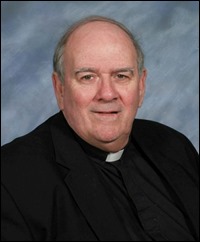 Many members of his family joined us there, and the community from Regina Cleri was part of the wake services. We gave thanks to God for the vocation of this priest who said yes to a call and spent so many years serving God’s people generously.
Many members of his family joined us there, and the community from Regina Cleri was part of the wake services. We gave thanks to God for the vocation of this priest who said yes to a call and spent so many years serving God’s people generously.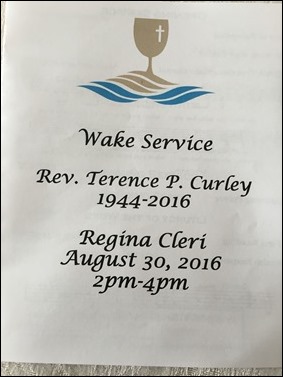
Father Terry was very beloved, and his wake was an opportunity for us to pray for him and thank God for him.
– – –
Finally, I’m very excited to announce that the Capuchin Friars who run the Shrine of Saint Padre Pio have offered to come to Boston with the heart of Padre Pio for his feast day this year.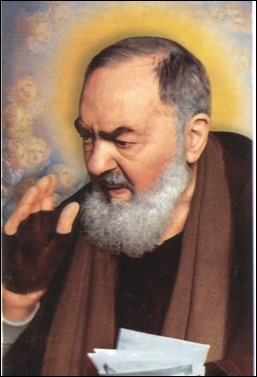
This is the first time any major relic of Padre Pio has left Italy, and we are so pleased that they have offered to come to Boston for this historic visit. We know that many people throughout our country have a great devotion to Padre Pio, so the friars have made this possible especially for those who are not able to travel to San Giovanni Rotondo in Italy to venerate his relics and pray for his intercession.
While the final details are still being worked out, we do know that the relic will be venerated in a number of different locations throughout the Archdiocese on September 21 and 22.
On September 23, which is also the Feast of St. Padre Pio, his relic will be venerated at the Cathedral of the Holy Cross throughout the day.
Stay tuned for more information and help spread the word! May Padre Pio’s powerful intercession bring us all closer to the merciful heart of Jesus.
Until next week,
Cardinal Seán
